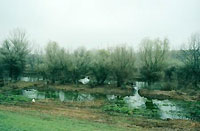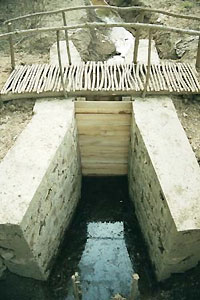
The earth needed for the construction of the dykes was excavated from pits, called "kubikgödör" (clay-pits). These pits are usually situated in rows, which run parallel to the dykes, on the side towards the riverbed (i.e., in the floodplain area). This is also the case in Nagykörű. Often dubbed "fish-cradles" or "fish-cemeteries", they serve as excellent spawning grounds after floods, but they act as traps for millions of spawn as the water recedes. They often dry up completely, and the trapped fish perish.
Records from the 19th century indicate that people, even during this period utilised the clay-pits as fish nurseries. However, the ditches excavated at that time have silted up. The remnants of these ditches could be located during the preparatory phase of the project, and they provided guidance for the rehabilitation of the area.
The "Nagykörű idea" calls for the connection of the clay-pits with the ditches, making it possible for the water, together with the fish, to drain into the river as the floods recede. The implementation is based on a careful survey. The network of ditches connecting the bottom of the pits drains water towards the river. With the help of the sluice, built on the lowest point of the drainage channel of the system, water can be retained after the spring floods in sufficient quantity to last throughout the summer. The sluice also allows the regulation of the water level. The system is best drained at the end of summer or in the autumn, when the young fish have grown stronger. The draining of the pits is also the time of harvest: the larger fish can be netted from the drainage channel, while the spawn is released into the river. Not all pits are connected to the system: some are retained as feeding grounds for birds.



